28 years later: Revisiting the Wellington Street Circuit
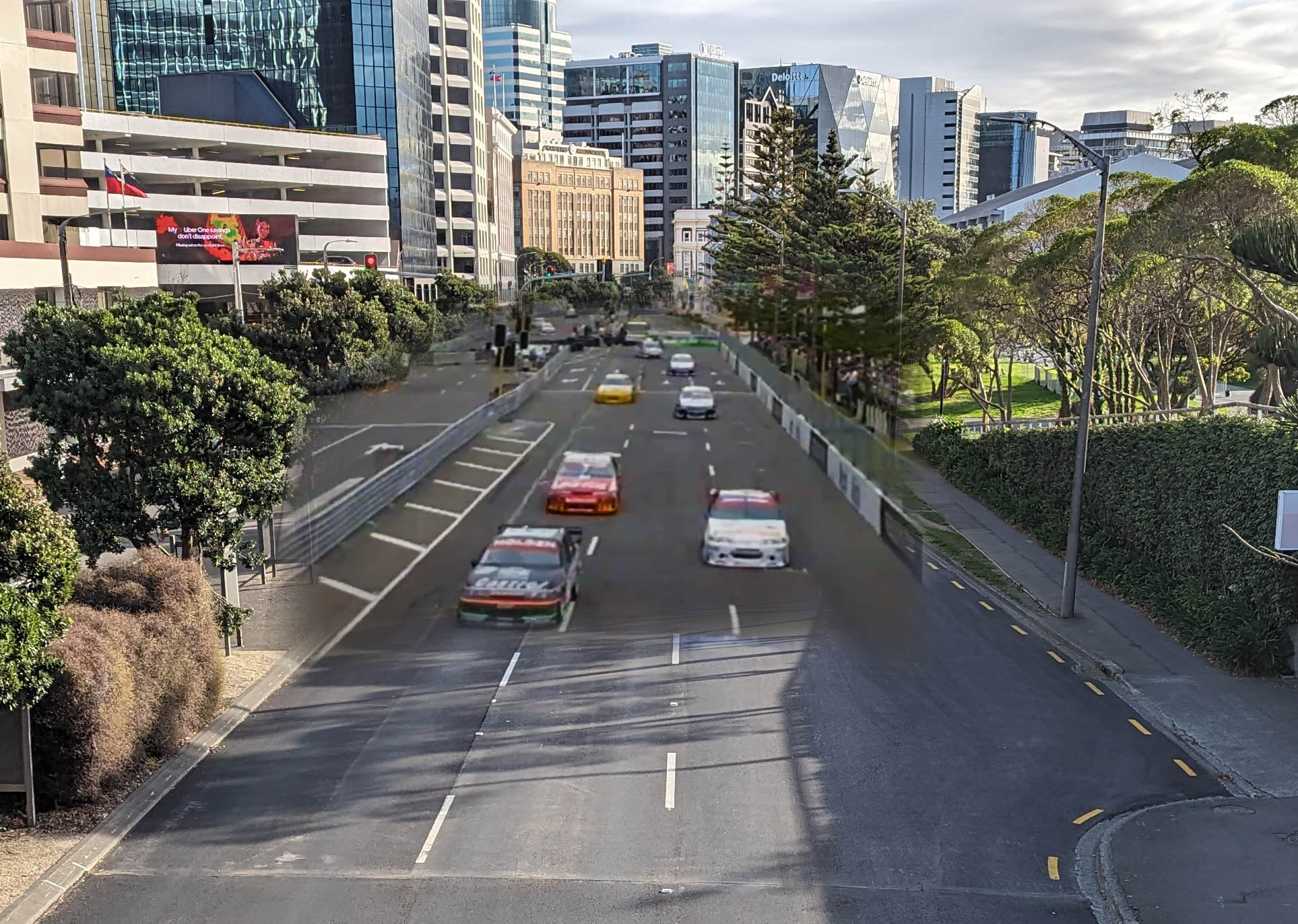
FOR a vast majority of the population, the fading yellow markers that sporadically appear across Wellington’s Commonwealth walkway, a public walkway / running track that borders the waterfront and the battlements alongside the elevated Frank Kitts Park, would mean absolutely nothing.
There are perhaps six or eight that you can spot, but only if you look. Some elements of yellow are reasonably strong, but in many places they are just blobs of colour on a windswept bitumen, neither connected to anything else nor obvious in their meaning or purpose.
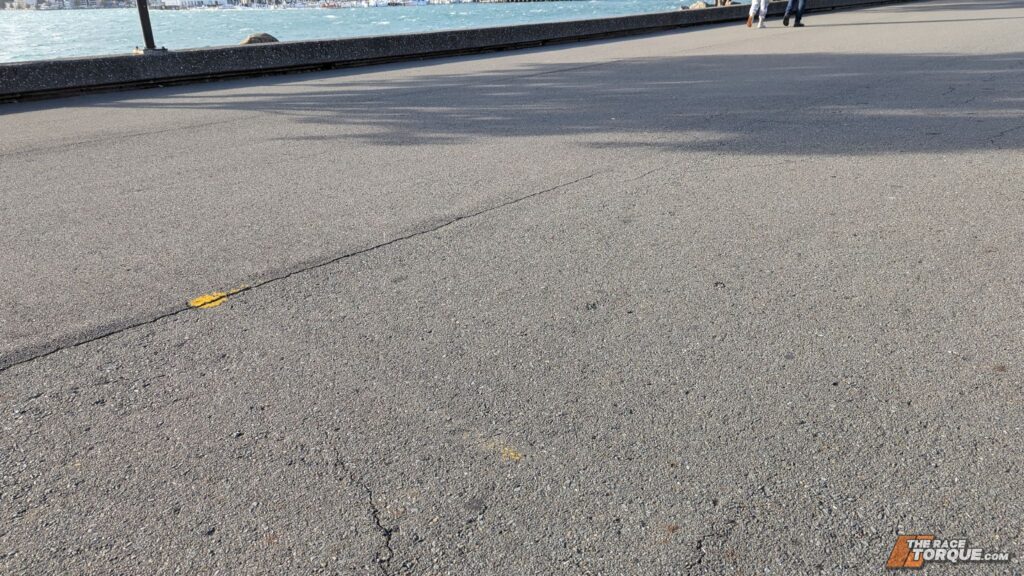
They could be survey lines painted by the council, showing where underground services are located.
Or, they could be faded remnants of some form of street art, or tourism promotion.
Ironically, the latter is not far from the truth.
Indeed, these yellow lines, barely discernable in their faded and patchy state, carry plenty of significance for Wellington’s tourism push in the 1980s and 1990s.
They also double as the only visible reminder of the New Zealand’s capital’s rich motorsport history.
These yellow markers to history are now the only visible reminder of the Wellington Street Circuit – the delineators for grid markings from the circuit’s start line of its initial iteration in the mid 1980s.
Otherwise, there are no monuments. No statutes. No plaques. No other reminder of a racetrack that helped put the city at the very bottom of Aotearoa’s South Island on the global motorsport map for little more than a decade.
There’s no sign of the Brock’s, Johnson’s, Murphy’s and other international stars that put on an annual show for 30,000 passionate New Zealand racing fans.
And, given the wind and spray blowing across the walkway on this Thursday morning, they won’t be there for long.
Much like the race track they heralded, it seems time will soon claim the last reminder of motorsport on the capital’s harbour.
STREET RACE
THERE are plenty of sources to gather information on the Wellington Street Races, but we’ll give you the cliffs notes version here.
In the meantime, we’d suggest dropping over to our friends at the V8 Sleuth Superstore and ordering New Zealand author Richard McGee’s excellent and extremely definitive history of the Wellington Street Races across the eras – as well as being an excellent source of history it’s just a damn good read. It’s also on sale right now, which is fortunate timing.
First pitched in 1984 and first staged as the Nissan 500 in 1985, the Wellington Street Circuit was founded as a marquee event for Touring Cars in New Zealand, and instantly attracted international attention.
In 1987 the now Nissan Mobil 500 became a round of the ill-fated and short-lived FIA World Touring Car Championship – following the Toohey’s 1000 and Calder Park rounds in Australia; The Eggenberger Sierra’s that had won and then lost Bathurst, claimed the only World Championship Wellington event that year.
Even with the WTCC’s demise the race retained international interest, with overseas teams and Aussie outfits heading across the ditch at the conclusion of the Aussie season.
The tight nature of the circuit meant it became a stronghold for BMW’s M3 Group A contenders with the Schnitzer team in particular finding huge success there. Remarkably, it’s one of the few events that a Gibson Motorsport Nissan GTR was entered in but didn’t win.
Group A’s slow demise saw the introduction of Super Touring in 1993, the last year of a 500km endurance race on Wellington’s streets and the first year of a revised layout, required due to the ever-changing developments on the Wellington waterfront. It switched to sprint racing in 1994, wasn’t held in 1995 after local politics and a lack of funding took over, and then returned for a final hurrah in 1996 when the Aussie V8’s headed over for a two-event Tasman Series, the Wellington event following a packed round at Pukekohe the weekend before.
And then, just like that, it was all over. A mixture of funding, local politics and the fast-paced development on the previously underutilized waterfront causing it to be placed in the too hard basket.
Several resurrection proposals were floated – Supercars seriously pitched it prior to getting the Hamilton Street Race off the ground – but ultimately none of them got off the ground and 1996 would turn out to be the Wellington swansong.
28 YEARS LATER
THE irony of Wellington’s demise as a street circuit destination is that these days it would almost be considered a perfect market for a Street event.
Big enough to support the logistics, hotels, restaurants and entertainment requirements of a large event but small enough that the event would be much more than just a sideshow to the city.
It’s also clear that there is little appetite in the capital for such an event, with the changing political tides and vagaries seeing it low on the priority list, if even on it at all.
There’s also the issue of the location, one that the circuit had to contend with even in its formative years; As scenic as the Waterfront is, it’s also incredibly tight for a race track.
In the 1980s the Wellington harbor was mainly an industrial site: large moorings for shipping, lots of carparking and a vibe that would certainly not be described as cosmopolitan.
These days it couldn’t be more different. The enormous Te Papa – New Zealand’s rather excellent national museum – building dominates the Southern end of where the circuit once was and its construction was part of the reason the circuit changed direction and much of its location in 1993 for the final few years.
What were once carparks have been turned into running tracks, with leafy canopies and moorings for pleasure craft. There are food trucks, bars and restaurants and public art and spaces for functions and the like. All very 21st century modern city. Not conducive to a racetrack.
Regardless, it is here where TRT lands following the excellent first running of the Taupo Supercars event in April.
I have always been fascinated by Wellington’s street racing history: Growing up with a street circuit in the backyard – Adelaide – always meant I was keen to see how others did it. The strange, narrow circuit in New Zealand with it’s Armco barriers brushing the waterfront, several first-gear corners and general sketchiness was certainly different – and definitely appealing. The Macau of the South Pacific, perhaps.
So, having taken in an excellent ANZAC day dawn service at the National War Museum at the top of Taranaki Street, and having ambled around the incredibly beautiful Basin Reserve – New Zealand’s home of test match cricket – to take in some Black Caps history, it was town to the wharf to try and piece together the old street circuit, and see if anything remained.
VERSION CHOICE
THE WELLINGTON circuit changed many times in little more than a decade, so for simplicities sake we’ve charted the location of the final iteration; the 1996 circuit that the likes of Brock, Johnson, Bowe and a very young Greg Murphy tackled in what would be the circuit’s swansong.
It’s the most current and, for a 12-year-old version of this author at least, the most memorable version of the circuit.
THE LAP
HEADING SOUTH, the 2.5 kilometre lap begins on Jervois Quay just prior to the imposing City to Sea bridge, which was a feature of the 1996 races.
The grid was on the left hand (Southbound) track of the road, with a short dash to the Turn one chicane, which crossed the medium and then back again. The area where this chicane once was has been filled with a tree-lined medium, but the bridge remains a visual focal point in the background of what was an incredibly tight first turn.

Jervois Quay splits at this point and becomes Cable street, which the circuit followed South East. Crossing Taranaki street and the heritage gates into the harbour precinct, in its final year the circuit passed on the left the newly constructed monolith that is Te papa, the museum.
Just prior to the museum was a kink, one where in the third and final race of the 1996 event Tony Longhurst quite famously drove his Castrol Falcon into the side of Peter Brock’s HRT Commodore, turfing the Touring Car hero into the barriers on driver’s right – basically right at the camera position not even remotely protected by a three-layer high temporary armco barrier.
Brock’s car ended parked across the road almost directly half-way down the frontage of Te Papa, which was still in the final stages of construction at the time.

A hard braking zone into a 90-degree left hander was next, the track heading left into what was an industrial precinct but has now given way into parking for the museum, residential developments and parks. The entry to the main carpark today follows the course of the circuit, including the slight kink to the right into what was known as the Barnett Chicane, and then the left-hander that brought the field alongside the water for the first time.
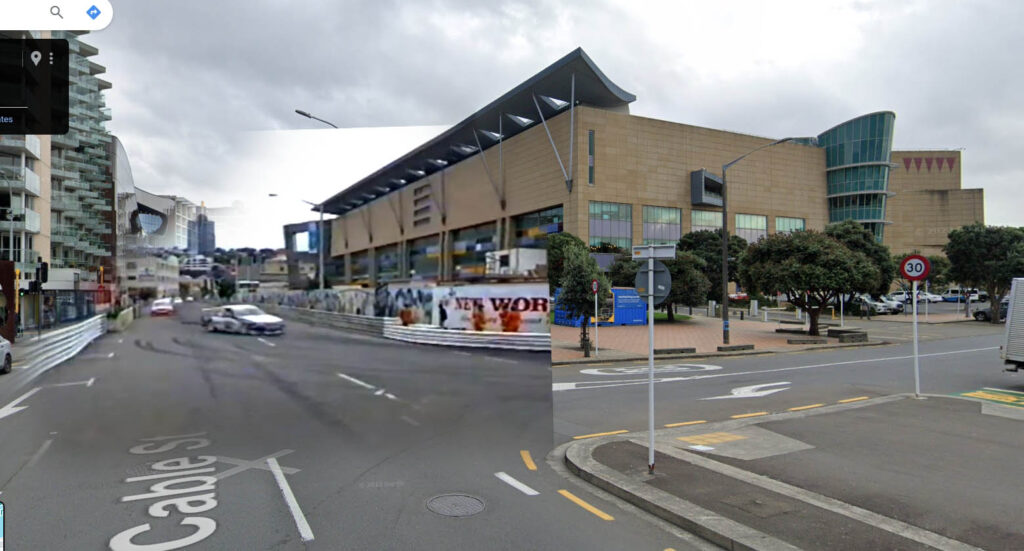
There are other visual references here too: On the right hand side is the QT Wellington hotel: a giant black monolith that in the day saw people hanging out of the windows gaining a great vantage point over the run down Cable Street and into the big stop at the left hander at the Museum.
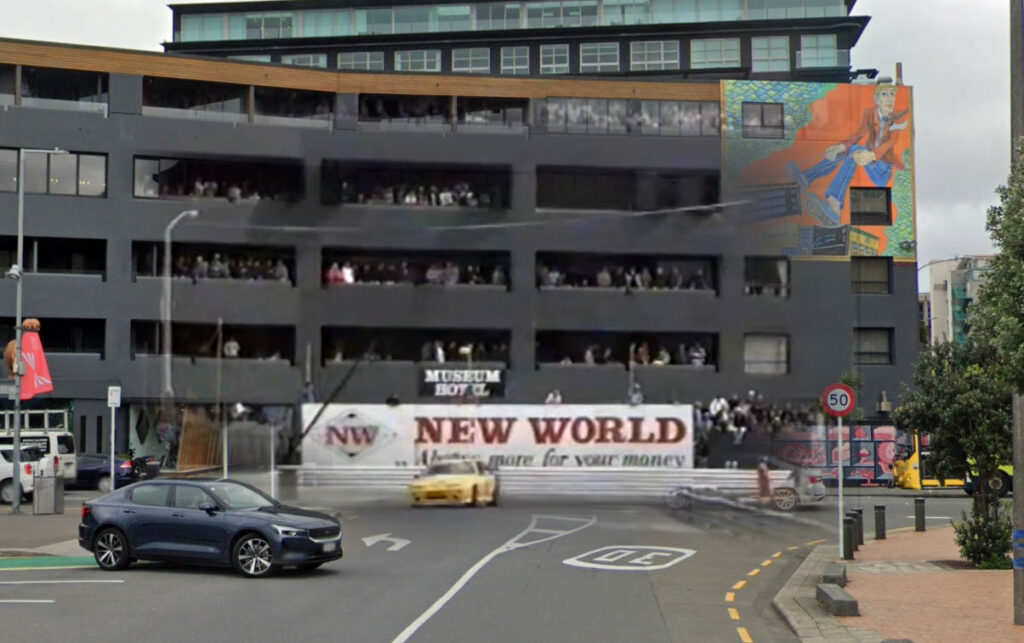
Here there could be more evidence of the circuit that used to be – several concrete blocks shaped suspiciously like those used in temporary street circuits, complete with holes for fencing and the drainage / forklift holes at the bottom, are still in use throughout the carpark.

What once was roadway along the waterfront is now very much public space, with no sign of the circuit that once was.
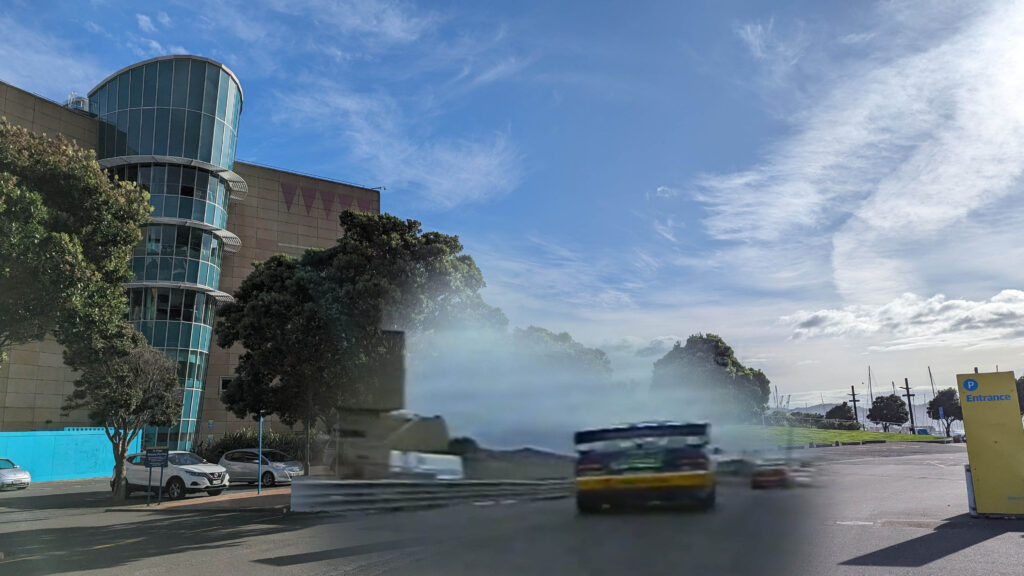
Also, it’s interesting to note the water lapping beneath the docks: there won’t have been many circuits in the world where Touring Cars raced on a roadway supported by hundred year-old timber piles into the sea..
Sweeping through a tight but quickish left at the waterfront side of the Museum, the field then headed due West alongside the water – in 1996 a large ship was moored alongside this straight. Today there are food trucks, just opening for business as we take in our walk.




Bottom: Where now there are food trucks, there once was a braking zone and a left-hand corner. The cars would turn in at basically the last light pole on the left of shot, and aim at the orange brick building, Shed 22.
Heading back towards the city, the layout today resembles the circuit that once was: A heavy stop into a slow left called ‘Union’, then an awkward, long and slow right. On the left is one of the many old warehouse and shipping buildings now repurposed for modern use: Shed 22 features in several in-car shots in the 1996 broadcast: Today it’s an excellent bar and eatery. 10/10 would recommend.

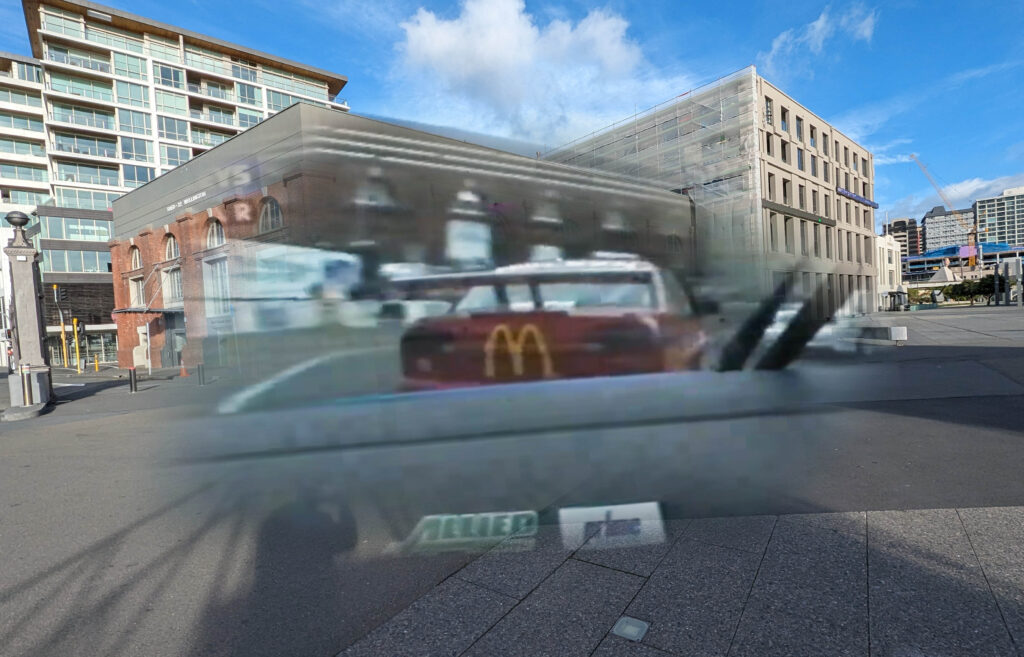
This tight section was awkward and slow but eventually fired the cars north again, back alongside the water onto the Taranaki street wharf and alongside the crane ship, the SS Hikita, which was a feature in the back of several shots from the broadcast in the day and remains an impressive tourist attraction nearly 30 years later.
On the left is the Boating club and the Whairepo Lagoon – but it’s here where things get confusing and also where any ideas of a recreation fall somewhat short.



At some point in the intervening three decades, a section of roadway separating the lagoon with the open harbour was removed, replaced with a walkway and cycleway across the inlet’s gap. Great for walking, but you’re not going to drive a car across it.

We can tell from the broadcast of the day that the roadway followed roughly the course of the current footbridge, bringing cars across ‘the gap’ and onto the familiar pathway alongside Frank Kitts Park.
It’s here that our old grid markings from earlier in this tale can be found, the location familiar thanks to the almost medieval-style battlements that act as the grade separation between the elevated park and the walkway and harbour front.
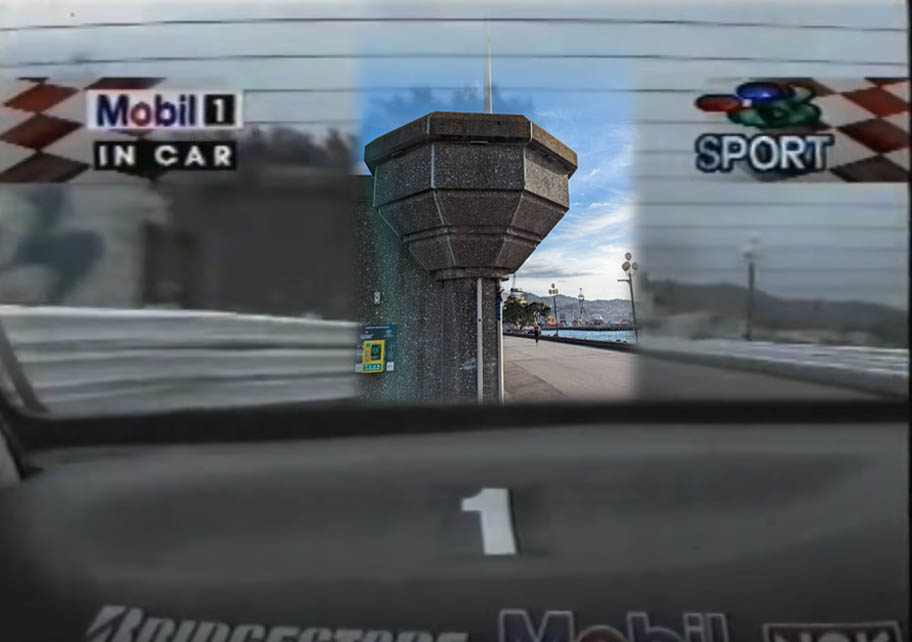
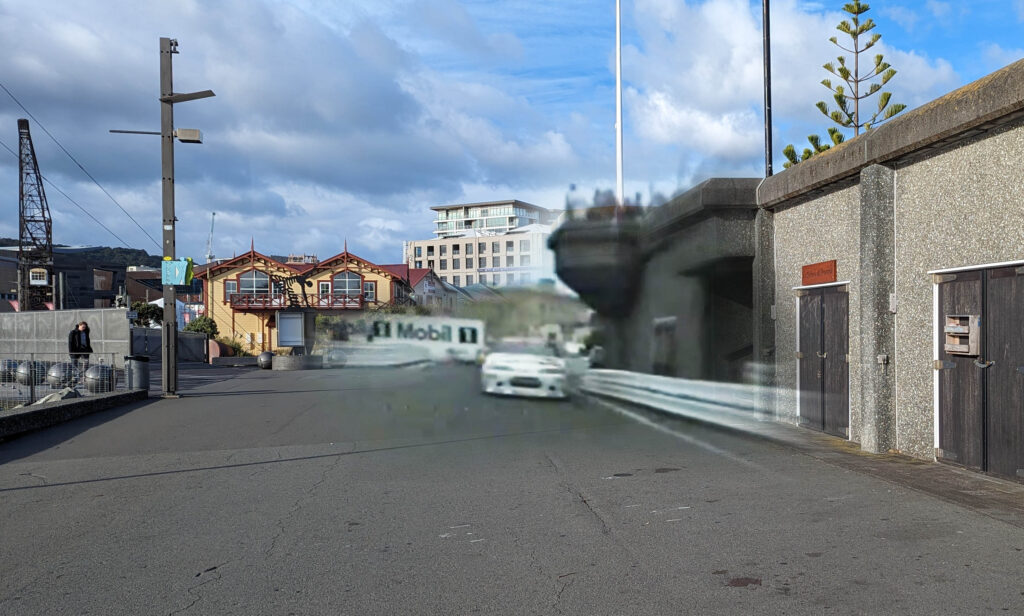



As the old grid markings continue to fade through the constant battling of the elements – and today, nearly 100km/hr wind gusts, the nearby airport would record gusts of 110km/hr later on ANZAC day – we walk towards what is now known as TSB arena, an indoor sporting centre converted out of old shipping warehouses on the Queen’s Wharf.
Another chicane existed here: the cars went left, then right as the re-joined the Jervois Quay heading North.
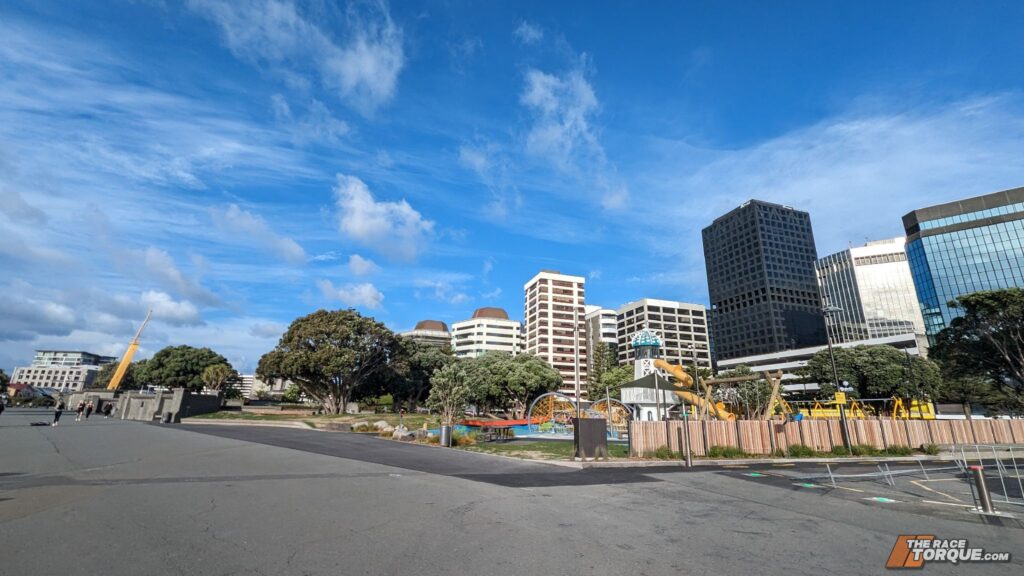
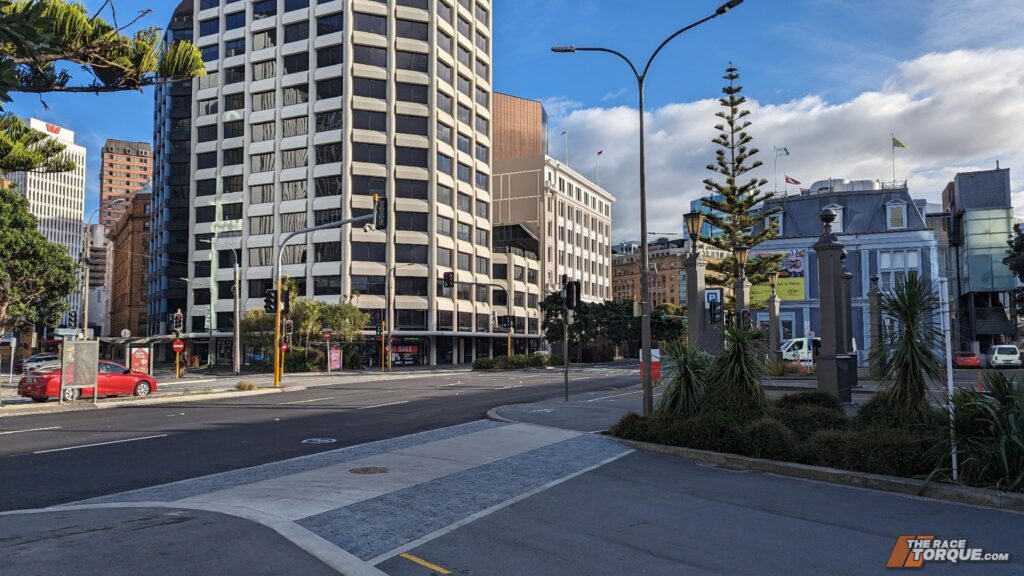
The Wharf area – driver’s right – is now a fantastic area for events and foodies in a perfectly acceptable modern reinterpretation of a working-class area.
The race track, meanwhile, swept gently right; past what is now the New Zealand Academy of fine arts with it’s notable gold dome atop the Northern point of the triangular-shaped building.
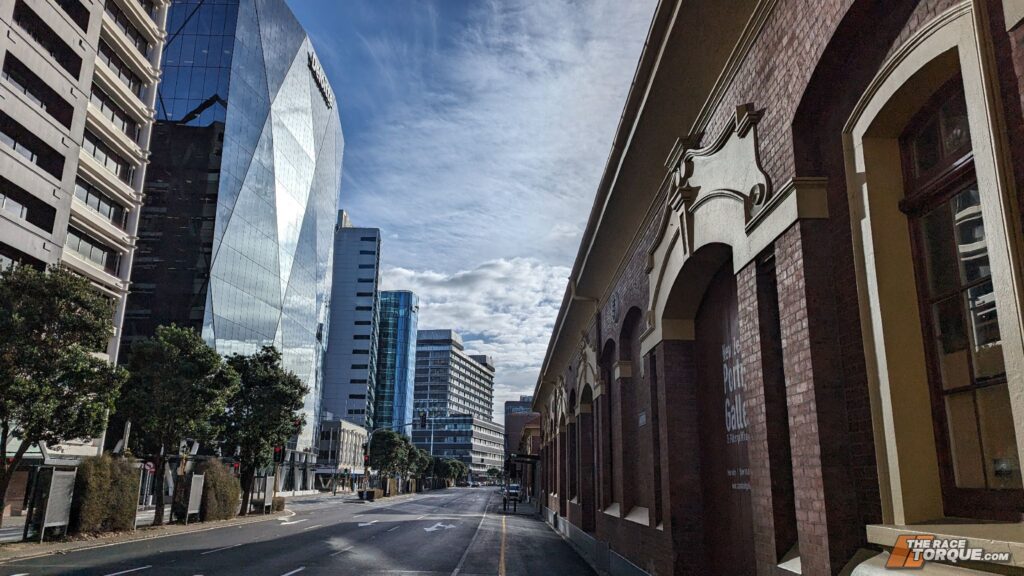
Straightening up, the field would then brake for the famous Wellington hairpin; a constant of every iteration of the circuit, even if they were in different locations along the Quay at various points.
In fact, in the past iterations of the circuit the hairpin was actually behind the warehouse buildings that split the main road from the dock itself – the hairpin was essentially the first corner on the circuit, set up in an otherwise vacant carpark. Today it’s a hive of activity in and around the arena area, with function spaces and bars.
Conveniently, the pedestrian crossing to the other side of the six-lane road is almost exactly where the barriers were on the outside of the corner back in the day, so it’s easy to get a visual of how tight this corner was: first gear, late apex and right on the exit.
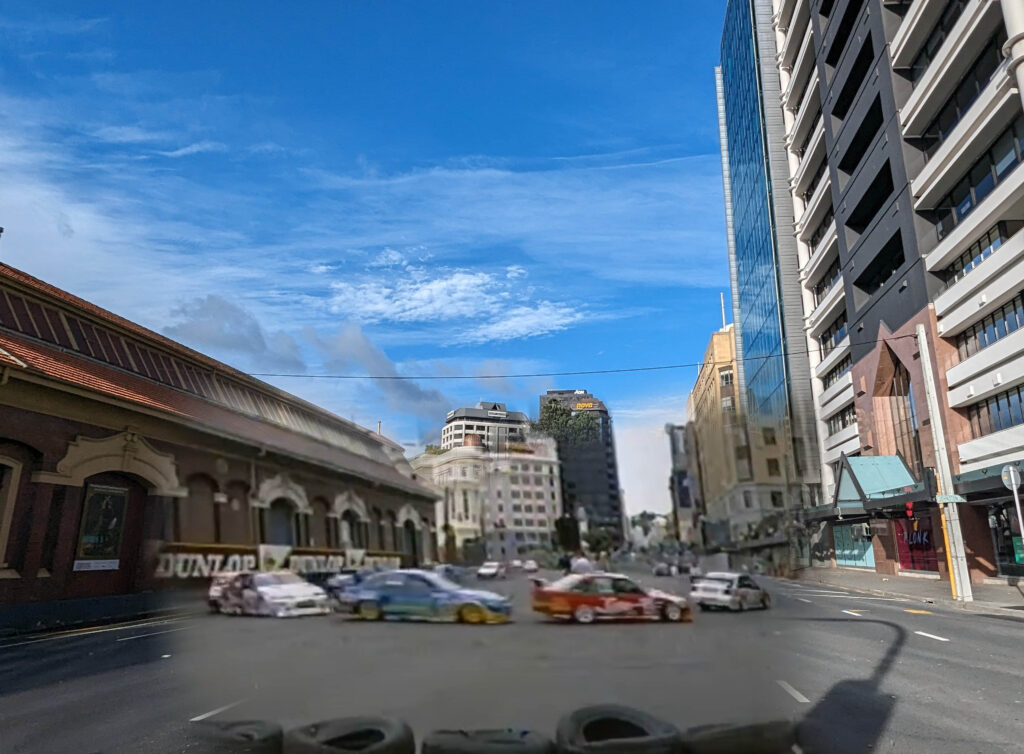
With the circuit heading back on itself, the cars ran basically side-by-side – some North, some South – as the circuit gathered speed back towards the end of the lap.
A gentle sweep to the left made an already narrow circuit seem even tighter, before the road straightened up briefly before stopping for the final complex.
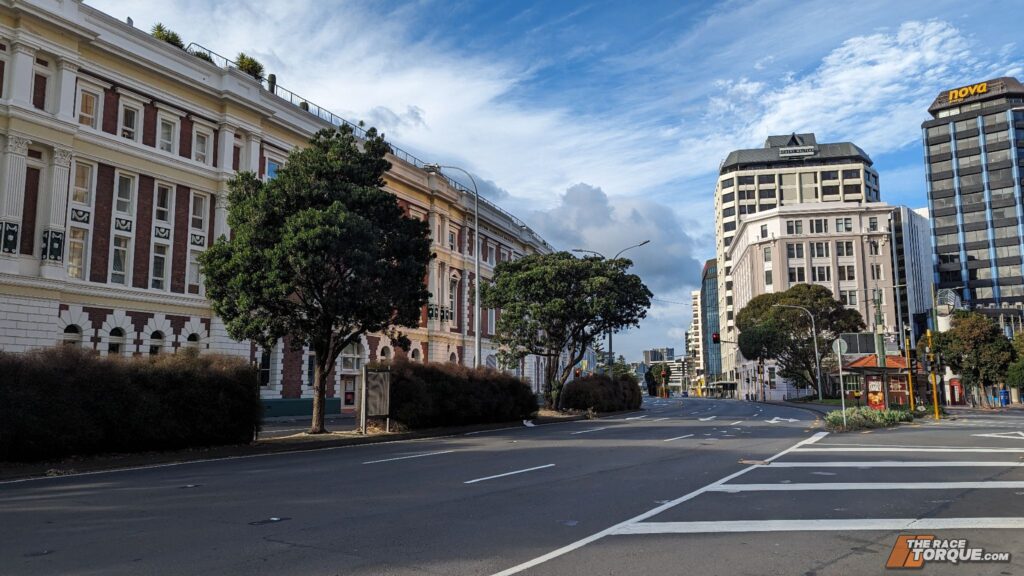
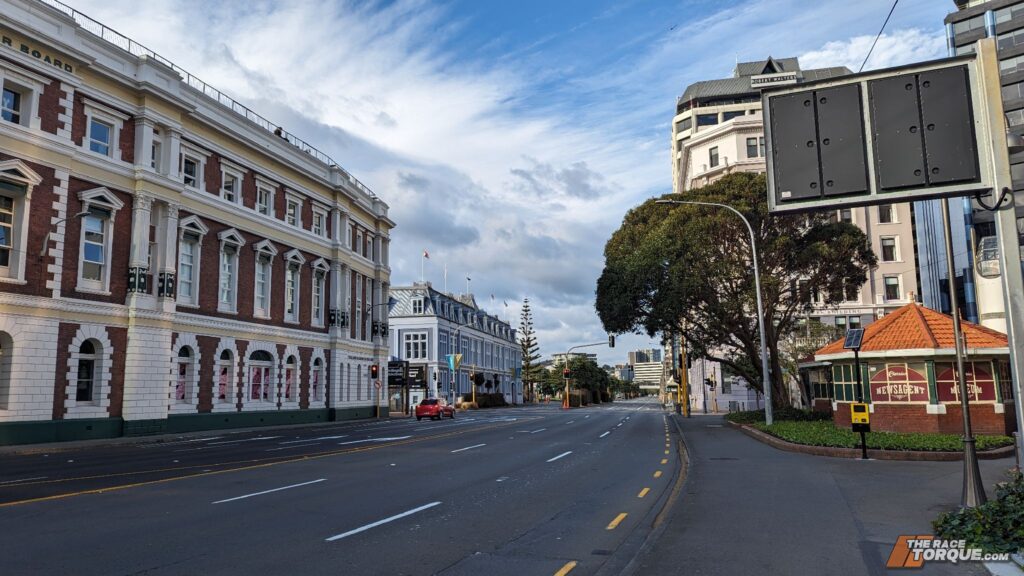
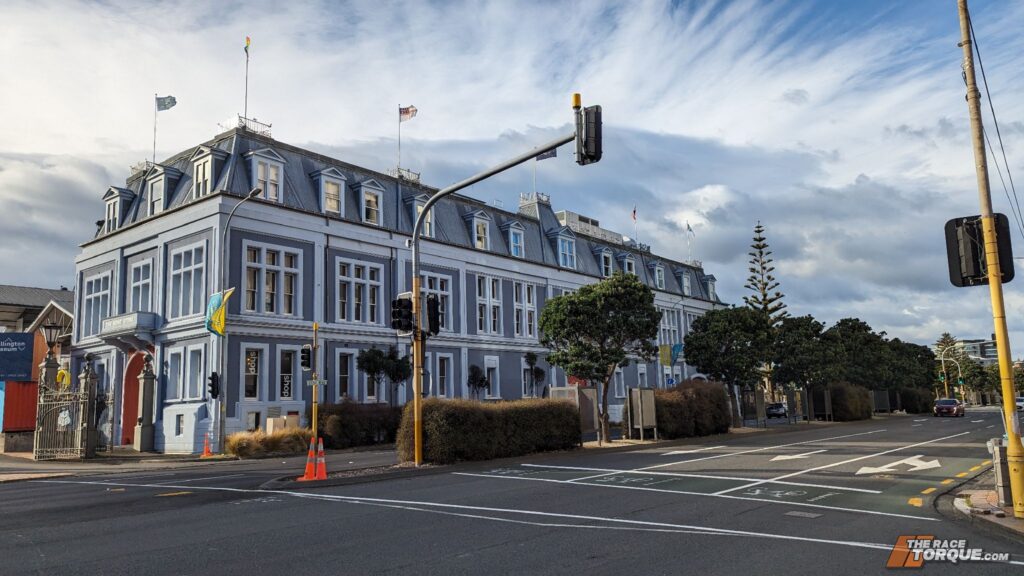
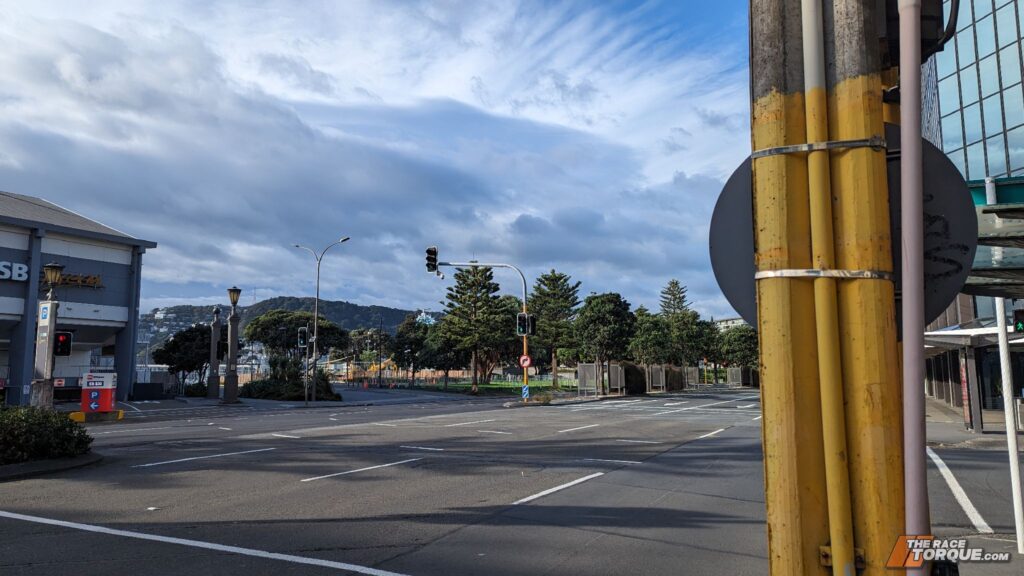
BOTTOM: The chicane that brought cars back to the other side of the road. Stay on the right and you’d be in pit lane. There has been some changes to the junctions here: in the day there was room for cars to emerge from the roadway on the left to head north, then re-join just beyond that.
This was back by the TSB arena: where the cars would on one side fire out of the chicane and head North to the hairpin, the Southbound track would see them negotiate a tight chicane as they crossed the medium of the six-lane road at the junction with Hunter Street and return to the Southbound lanes, with what would be the regular flow of traffic.
Utilising both sides of the road, pit lane was straight ahead – the Touring Car teams bringing their transporters across the ditch for this event, several of them clearly parked up in the back of several shots throughout TV3 NZ’s 1996 broadcast.
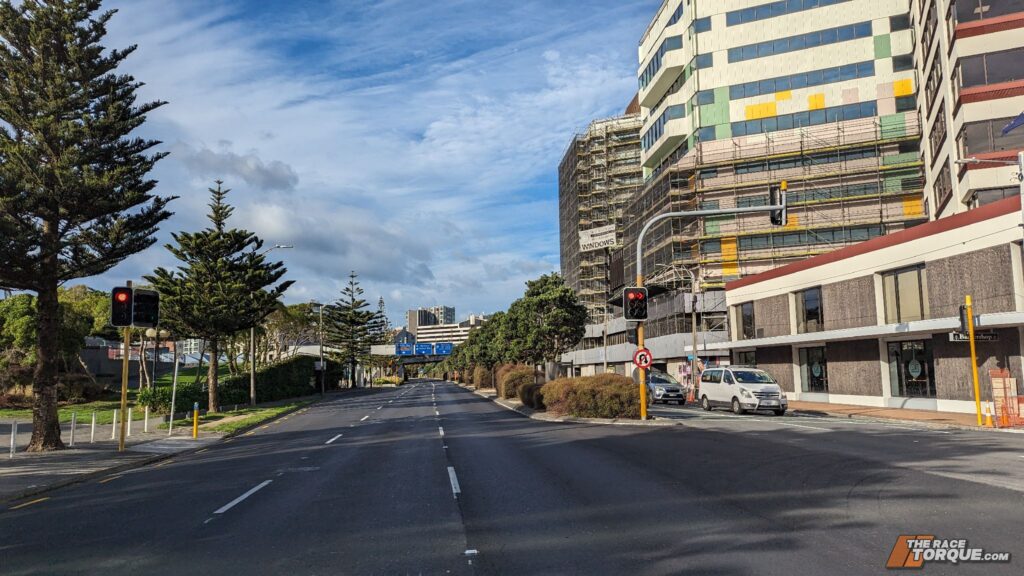
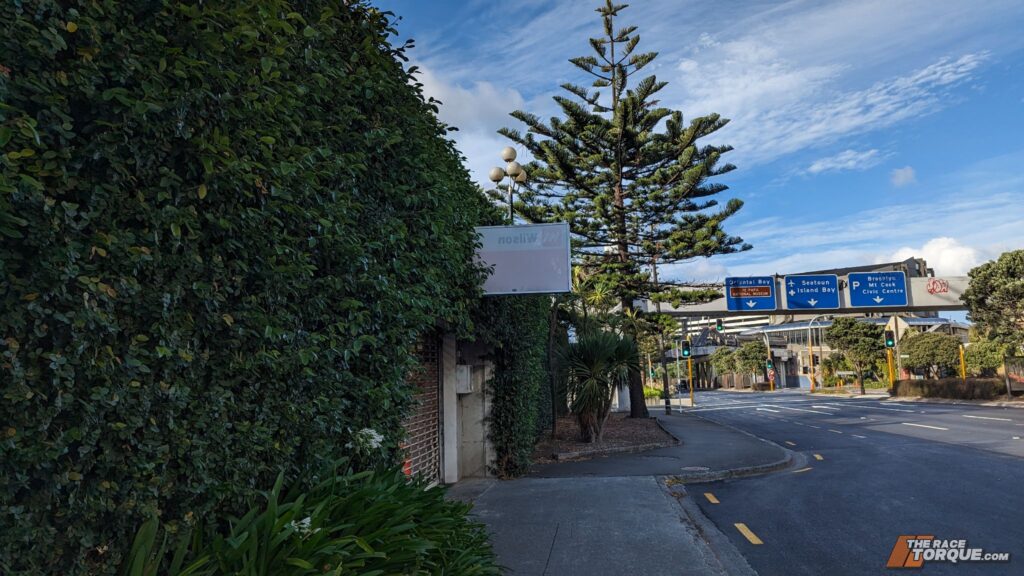
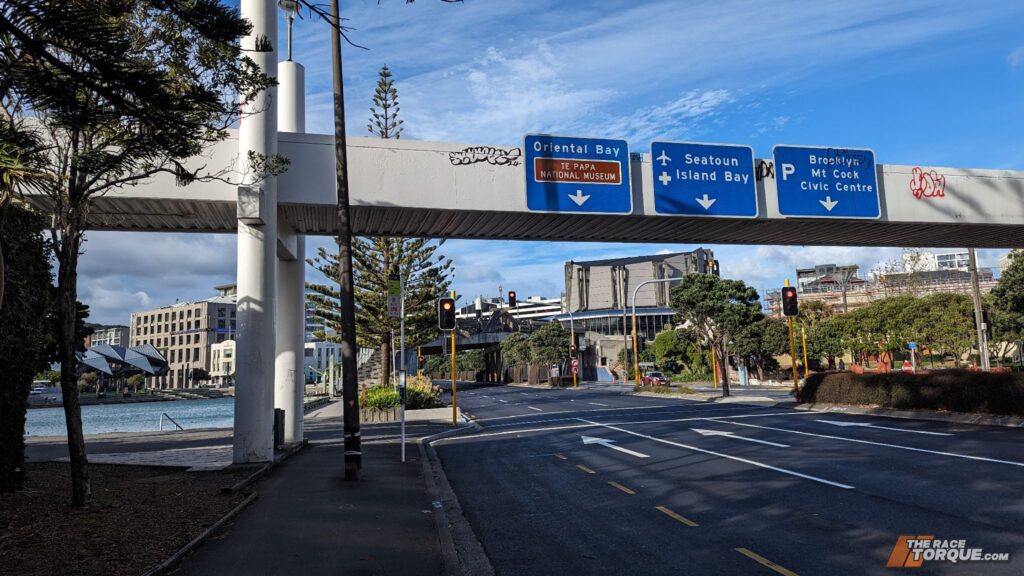
And with that, the lap was almost done: gathering speed, the field then passed Frank Kitts Park, this time on their left hand side, before crossing the line just prior to the pedestrian bridge that connects Harris St foot traffic with the park and the waterfront. It was on this bridge that the TV camera positioned above the circuit was located.
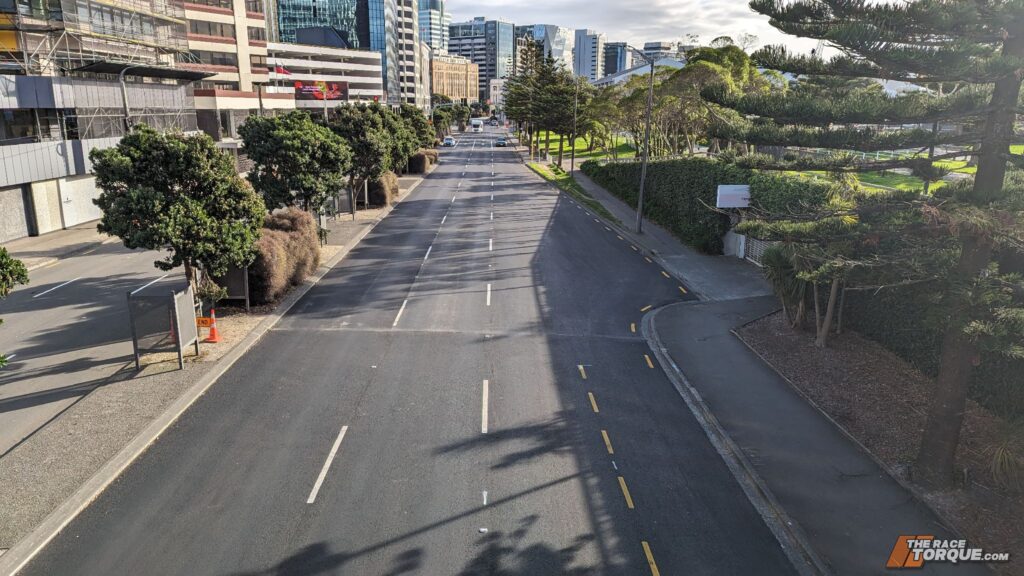
And that was the lap. It was tight, it was technical, it had several instances where first gear was used and despite this, in its final hurrah, it produced quite good racing as Kiwi heroes Paul Radisich and especially Greg Murphy put on a show – the latter winning the final ever race on the Wellington streets.
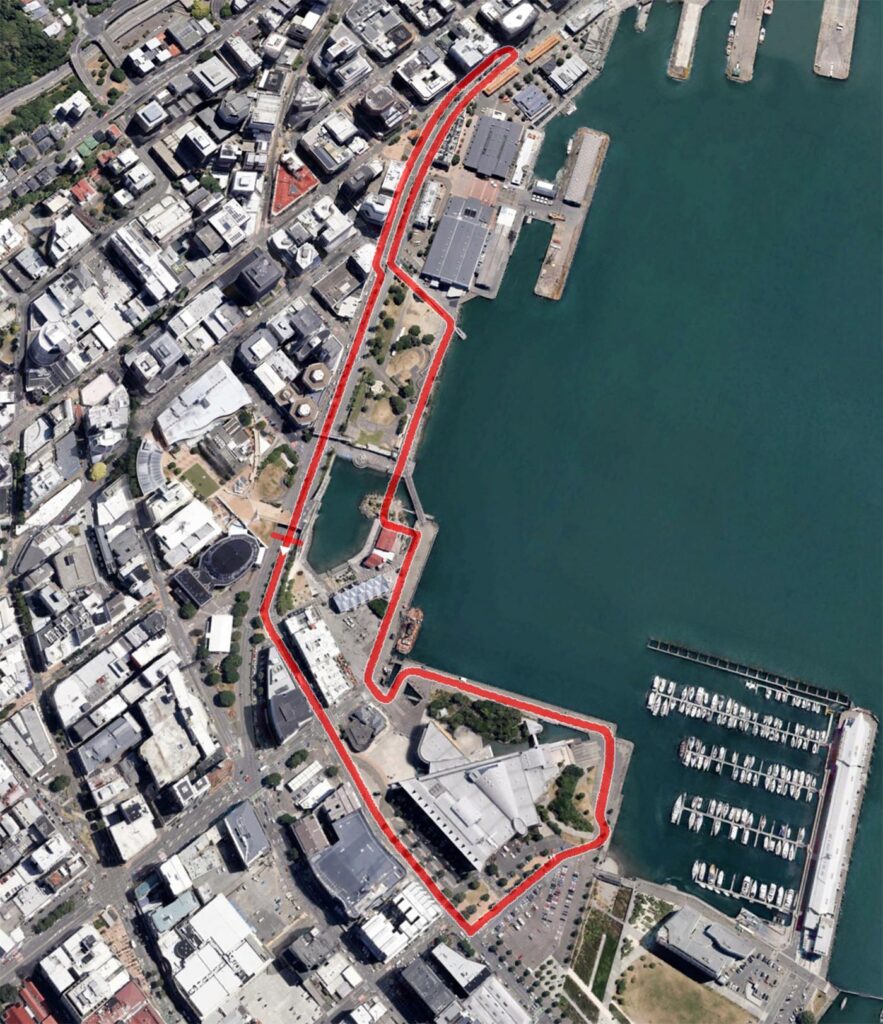
Wellington 1996 and beyond
The 1996 Wellington sprints, and the preceding Auckland-backed event at Pukekohe, would effectively be a soft launch for what would become V8 Supercars.
AVESCO had only just been formed and plans launched for a 1997 season that, in the coming years, would effectively transform the sport beyond prior recognition.
By virtue of two race wins and a third, John Bowe claimed the final Wellington event overall however it was Greg Murphy who starred. Having shunted his Mobil HRT Commodore in practice, the Kiwi worked his way forward from sixth on the grid across the three, 15-lap sprints to get himself into outright contention by the final race.
There, in an inspired charge and with 35,000 Wellingtonians madly cheering him on, he slipped past Bowe with a move at the hairpin to take the lead and win what would be the final Wellington race, fellow Kiwi Paul Radisich – driving one of Alan Jones’ Pack Leader Falcons – in second.
While winning Sandown and Bathurst with the outgoing Craig Lowndes had firmly injected Murphy into the consciousness of the motorsport public in Australia, his Wellington performances were a sign of things to come as he launched his full-time V8 Supercars career the following year as Lowndes’ replacement at HRT.
The event was a success, too. According to Richard McGee’s excellent book, the City Council, backer Mobil and AVESCO signed an in-principle agreement to lock in the event until the year 2000.
As history records, however, a final deal would never be done. Issues around the circuit layout, access and other areas couldn’t be rectified and the race never eventuated; Supercars ultimately turning up at Pukekohe in 2001.
A second attempt to renew the race was brought in 2006, when Pukekohe’s initial deal was due to expire.
McGee reports that by this point a Wellington Council investigation into the proposal reported that the circuit could no longer fit in the waterfront area – though a split council couldn’t agree anyway.
Supercars went to Hamilton, instead, and then back to Pukekohe before this year heading further South to Taupo for the first time.
Wellington, meanwhile, got on with being New Zealand’s capital, and the signs that a street race had ever even inhabited their city streets began to blow away in the strong winds at the bottom of the North Island.
Today
WELLINGTON is probably better known today as the home of the special effects house, Weta Workshop – the place that developed the Lord of the Rings special effects – more than it is a location for an international Touring Car race for more than a decade.
It is a shame that the history is not better recognised at some point amidst the extensive waterfront walkways, cycleways, parks, bridges or buildings.
At a point when the memories of the Tasman Series had faded and New Zealand sat relatively isolated in a motorsport sense, the Wellington Street Races offered a renewed international focus on Kiwi motorsport, both for those in Australia and those much further abroad.
The track, in its many incarnations and many variations, is a significant part of New Zealand’s remarkable motorsport heritage.
While motorsport fans remember, and websites like ours reflect on the history and its significance to the sport, in Wellington itself a few faded grid markings are all that remains of a rich chapter in the sport’s history in the land of the Long White Cloud.














